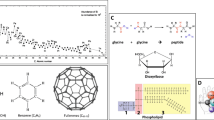Abstract
Had more philosophers of science come from chemistry, their thinking would have been different. I begin by looking at a typical chemical paper, in which making something is the leitmotif, and conjecture/refutation is pretty much irrelevant. What in fact might have been, might be, different? The realism of chemists is reinforced by their remarkable ability to transform matter; they buy into reductionism where it serves them, but make no real use of it. Incommensurability is taken without a blink, and actually serves. The preeminence of synthesis in chemistry could have led philosophers of science to take more seriously questions of aesthetics within science, and to find a place in aesthetics for utility. The necessary motion twixt macroscopic and microscopic views of matter in modern chemistry leads to the coexistence of symbolic and iconic representations. And in another way to the deliberate, creative violation of categories.
Similar content being viewed by others
References
Ammons A.R. (1990). The really short poems of A.R. Ammons. New York, Norton, p. 16
Bader R.F.W. (1990). Atoms in molecules: A quantum theory. Oxford, Oxford Univ. Press
Bensaude-Vincent B. (2005). Chemistry in the French tradition of philosophy of science: Duhem, Meyerson, Metzger and Bachelard. Studies in the History and Philosophy of Science, 36, 627–648
Bensaude-Vincent B. (2000). Lessons in the history of science. Configurations, 8(2):203–214
Bensaude-Vincent B. (2005). Faut-il Avoir Peur de la Chimie. Seuil, Paris
Berson J.A. (2003). Chemical discovery and the Logicians’ program. Weinheim, Wiley-VCH
Earley J.E. (1981). Self-organization and agency in chemistry and in process philosophy. Process Studies, 11, 242–258
Earley J.E. (1998). Modes of chemical becoming. Hyle, 4, 105–115
Feyerabend P. (1975). Against method. London, Verso
Galison P. (1997). Image and logic: A material culture of microphysics. Chicago, University of Chicago Press
Goethe J.W.v. (1971). Elective affinities. Tr. R. J. Hollingdale (p. 53). Hammondsworth, Penguin
Godfrey-Smith P. (2003). Theory and reality. Chicago, The University of Chicago Press
Golinski J. (2003). Chemistry. In: Poter R. (eds) The Cambridge history of science, Vol. 4. Eighteenth-century science. Cambridge, Cambridge Universaity Press, pp. 377–396
Grosholz E.R., Hoffmann R. (2000). How symbolic and iconic languages bridge the two worlds of the chemist: A case study from contemporary bioorganic chemistry. In: Bhushan N., Rosenfeld S. (eds) Of minds and molecules: New philosophical perspectives on chemistry. Oxford, Oxford University Press
Hacking I. (1983). Representing and intervening. Cambridge, Cambridge University Press, (p. 262)
Hoffmann R. (1995). The same and not the same. New York, Columbia University Press
Hoffmann R. (1988). Nearly circular reasoning. American Scientist, 76, 182
Hoffmann R. (2003). Why buy that theory?. American Scientist, 91, 9–11
Hoffmann R. (1990). Molecular beauty. The Journal of Aesthetics and Art Criticism, 48(3):191–204
Hoffmann R., Laszlo P. (1991). Representation in chemistry. Angewandte Chemie, International Edition in English, 30, 1–16
Komatsu K., Murata M., Murata Y. (2005) . Science, 307, 238–240
Laszlo P. (1993). La Parole des Choses. Paris, Hermann
Schummer, J. (2004). Why do chemists perform experiments? In D. Sobczynska, P. Zeidler, & E. (Eds.), Chemistry in the philosophical melting pot (pp. 395–410). Peter Lang (Frankfurt/M.).
Schummer J. (1997a). Scientometric studies on chemistry I: The exponential growth of chemical substances, 1800–1995. Scientometrics, 39, 107–123
Schummer J. (1997b). Scientometric studies on chemistry II: Aims and methods of producing new chemical substances. Scientometrics, 39, 125–140
Stein R.L. (2004). Towards a process philosophy of chemistry. Hyle, 10, 5–22
Ziman J. (1978). Reliable knowledge. Cambridge, Cambridge University Press
Author information
Authors and Affiliations
Corresponding author
Rights and permissions
About this article
Cite this article
Hoffmann, R. What might philosophy of science look like if chemists built it?. Synthese 155, 321–336 (2007). https://doi.org/10.1007/s11229-006-9118-9
Received:
Accepted:
Published:
Issue Date:
DOI: https://doi.org/10.1007/s11229-006-9118-9




